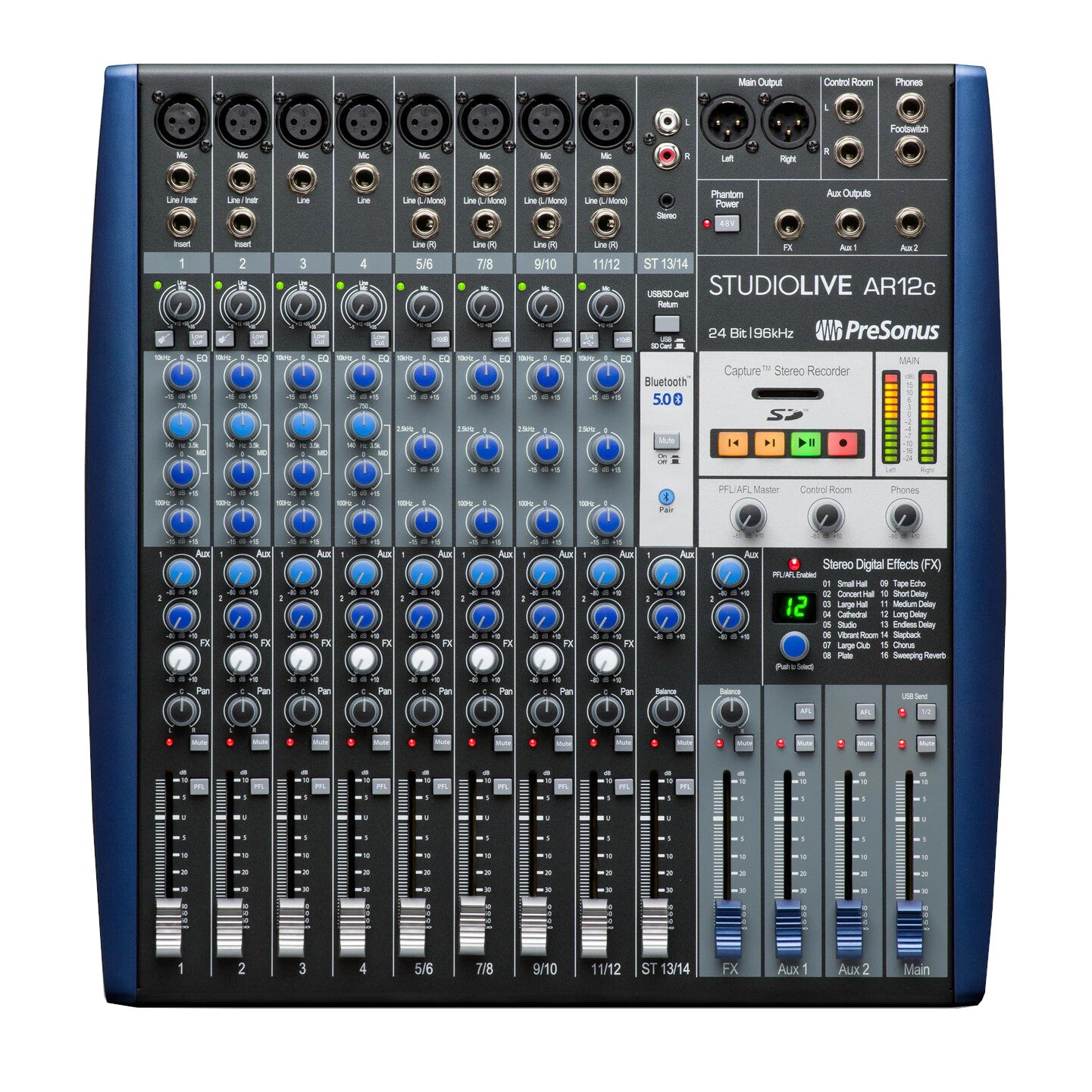
- Microphone Preamp
- Type: XLR Female, Class A XMAX
- Maximum Input level (unity gain): +9 dBu ± 1.0 dB
- Gain Control Range: 43 dB (+12 to +55 dB)
- Frequency Response to Analog Outputs: 20 Hz to 20 kHz, + 0.5 / -1.5 dB
- Frequency Response to USB (Direct): 20 Hz to 20 kHz, + 0.5 / -1.5 dB
- S / N Ratio to Outputs (+4 dBu): 94 dB
- THD + N (min. Gain, A-wtd): <0.01%
- Input Impedance: 1 kΩ
- EIN (+55 dB gain, 150Ω input, 20 Hz-22 kHz, A-wtd): Mono Channels: <128 dBu
- Common Mode Rejection Ratio (1 kHz, +55 dB gain): 65 dB
- Phantom power: + 48V, ± 3V, Global
- Instrument Inputs
- Type: ¼” TS Female, Unbalanced, Hi-Z
- Maximum Input Level (min. Gain, 1 kHz@0.5% THD + N): +9 dBu ±1.0 dB
- Gain Control Range: 43 dB, ±1 dB (+12 to +55 dB)
- Frequency Response to Analog Outputs: 20 Hz to 20 kHz, + 0.5 / -1.5 dB
- Frequency Response to USB (Direct): 20 Hz to 20 kHz, + 0.5 / -1.5 dB
- Dynamic Range (min. Gain, A-wtd): > 105 dB
- Dynamic Range (mid. Gain, unwtd): > 108 dB
- THD + N (1 kHz, -1 dBFS, A-wtd): <0.01%
- THD + N (1 kHz, -1 dBFS, unwtd): <0.01%
- Input Impedance: > 1 MΩ
- Line Inputs
- Type: ¼” TRS Female, Balanced
- Maximum Input Level (min. Gain, 1 kHz@0.5% THD + N): +26 dBu ±1.0 dB
- Gain Control Range
- Mono Channels: 40 dB, ± 1 dB (-5 to +35 dB)
- Stereo Channels: 0 dB or +10 dB (+10 dB Boost)
- Frequency Response to Analog Outputs: 20 Hz to 20 kHz, + 0.5 / -1.5 dB
- Frequency Response to USB (Direct): 20 Hz to 20 kHz, + 0.5 / -1.5 dB
- S / N Ratio to Analog Outputs (+4 dBu): 85 dB
- THD + N (1 kHz, -1 dBFS, A-wtd): <0.01%
- Input Impedance (Balanced): 10 kΩ
- Main, Control Room, Monitor, and FX Outputs
- Type (Main Outputs): XLR Male, Impedance Balanced
- Type (Control Room, Monitor, FX Outputs): ¼” TRS Female, Balanced
- Rated Output Level (Main Outputs): +24 dBu, ±1.0 dB
- Rated Outputs Level (Control Room, Monitor, FX Outputs): +18 dBu
- Frequency Response: 20 Hz to 20 kHz, + 0.5/-1.5 dB
- Dynamic Range (A-wtd): > 108 dB
- THD + N (Bandwidth 20 Hz - 20 kHz, -1 dBFS, unwtd): <0.01%
- Output Impedance: 100 Ω
- Headphone Output
- Type: ¼” TRS Female, Stereo, Unbalanced
- Maximum Output Level: 150 mW / channel @ 60 Ω
- Frequency Response: 20 Hz to 20 kHz, + 0.5 / -1.5 dB
- Dynamic Range (A-wtd): >103 dB
- THD + N (Bandwidth 20 Hz - 20 kHz, -1 dBFS, unwtd): <0.01%
- System Crosstalk
- Input to Output (Ref = + 4dBu, 20 Hz to 20 kHz, unwtd): -90 dBu
- Adjacent Channels (Ref = +4 dBu, 20 Hz to 20 kHz, unwtd): -85 dBu
- Signal Level LED
- Signal: -30 dBFS (pre-EQ)
- Clip: -3.0 dB before clip (pre or post-EQ)
- Channel EQ
- Low cut: 100 Hz, -18 dB/Octave
- High Shelving: ±15 dB @ 10 kHz
- Mid Peaking (Mono Channels): ±15 dB @ 140 Hz to 3.5 kHz (variable)
- Mid Peaking (Stereo Channels): ±15 dB @ 2.5 kHz
- Mid-Band Q: Boost: 1.0, Cut: 2.5
- Low Shelving: ±15 dB @ 100 Hz
- Digital Audio
- Host interface: USB 2.0
- ADC Dynamic Range (Component): 114 dB
- ADC Dynamic Range (Measured: A-wtd, 48 kHz): 105 dB
- DAC Dynamic Range (Component): 114 dB
- DAC Dynamic Range (Measured: A-wtd, 48 kHz): 105 dB
- Signal-to-Noise (a-weighted): -96 dB
- Bit Depth: 24-bit
- Internally Supported Sample Rates: 44.1, 48, 88.2, 96 kHz
- Jitter: <80 ps RMS (20 Hz - 20 kHz)
- Jitter Attenuation: > 60 dB (1 ns in => 1 ps out)
- SD Recorder
- Supported Media Format: FAT16 formatted SD™ card, FAT32 formatted SDHC™ card
- Media Storage Capacity: SD card: 2 GB; SDHC card: 32 GB
- Recording File Format: Stereo WAV
- Playback File Formats: Stereo WAV, MP3 (96-320 kbs, 32/44.1/48 kHz)
- Sampling Rate (WAV): 44.1 kHz
- Bit Depth
- Recording: 24-bit
- Playback: 16- or 24-bit
- Power / Environmental
- Connector: IEC
- Input Voltage Range: 90 to 240 VAC
- Recommended Ambient Operating Temperature: 0° to 40° Celsius / 32° to 104° Fahrenheit
- Physical
- Height 3.5” (89 mm)
- Width (Chassis only) 15" (381 mm)
- Depth 15.6” (397 mm)
- Weight 11.9 lbs (5.4 kg)
Why Choose SoundPro?
Since 1973, SoundPro has been the trusted source for audio, video, and lighting gear. Whether you're starting your AVL journey or are a seasoned professional, we're here to help you every step of the way.


